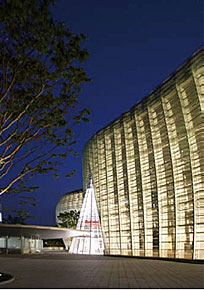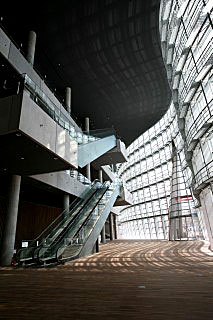 |
 |
 |
Night view of the entrance to
the National Art Center, Tokyo |
 |
Tokyo's "bubble buildings" are so dubbed because most were planned at the height of the freewheeling, big-spending "bubble economy" of the late eighties and early nineties. After the bubble burst these grand projects were already in the hopper, but by the time they were completed and ready for occupation the boom times were long over.
The newly opened National Art Center, built on choice mid-Tokyo real estate formerly occupied by the National Defense Agency, is precisely speaking a post-bubble project, since construction did not begin until 2000, but it has been in the planning stages since the seventies, and its grandiosity is decidedly bubblesque. Also, like the nearby Mori Art Museum atop Mori Tower in the ultimate bubble development, Roppongi Hills, it has another bubble-like attribute: no collection of its own. Opinions may differ as to whether this is a sad statement on society's commitment to art these days, or an innovative and practical response to current economic realities. However, it does result in a rather jarring contrast between the package itself and the contents, or lack thereof.
The National Art Center exemplifies this juxtaposition. Its vast galleries (14,000 square meters!) are an unending expanse of plain white walls uniformly lit by vaguely industrial fixtures far overhead. The point, presumably, is to provide a literally blank slate for whatever exhibition comes its way.
The inaugural exhibit that closed in late March, "Living in the Material World," offered an exhaustive and exhausting laundry list of "'things' in art of the 20th century and beyond" -- beginning with a Cezanne still life and racing through cubist works by Picasso and Braque, Duchamp's readymades, and Warhol's soup cans to contemporary installations featuring arrangements of found objects. The exhibit catalog attempted to link this kitchen-sink "things" theme to the Center's lack of same with a positive spin: "The National Art Center . . . does not accumulate 'things,' that is to say, it is an art museum without a collection. . . . By casting a fresh eye on the material world, we simultaneously explore the needs of a museum for the new age."
Whatever one may think of this approach, it is being pursued behind one of the most glorious facades seen on any museum anywhere. Architect Kisho Kurokawa, famous for designing airports, skyscrapers, and entire cities for emerging economies with money to burn (he is also currently a dark-horse candidate for mayor of Tokyo), has created a rippling multi-story exterior of curved glass that admits light into an airport-terminal-sized atrium replete with see-through elevators and restaurants suspended in midair. No doubt this will become a popular gathering place regardless of what is on display in the galleries modestly hidden in the back. But the Center curators are not taking any chances; their next show is devoted to Monet, a guaranteed draw in Japan if there ever was one.
 |
 |
|
Inside the lobby of the National Art Center
All images courtesy of
the National Art Center, Tokyo |
|